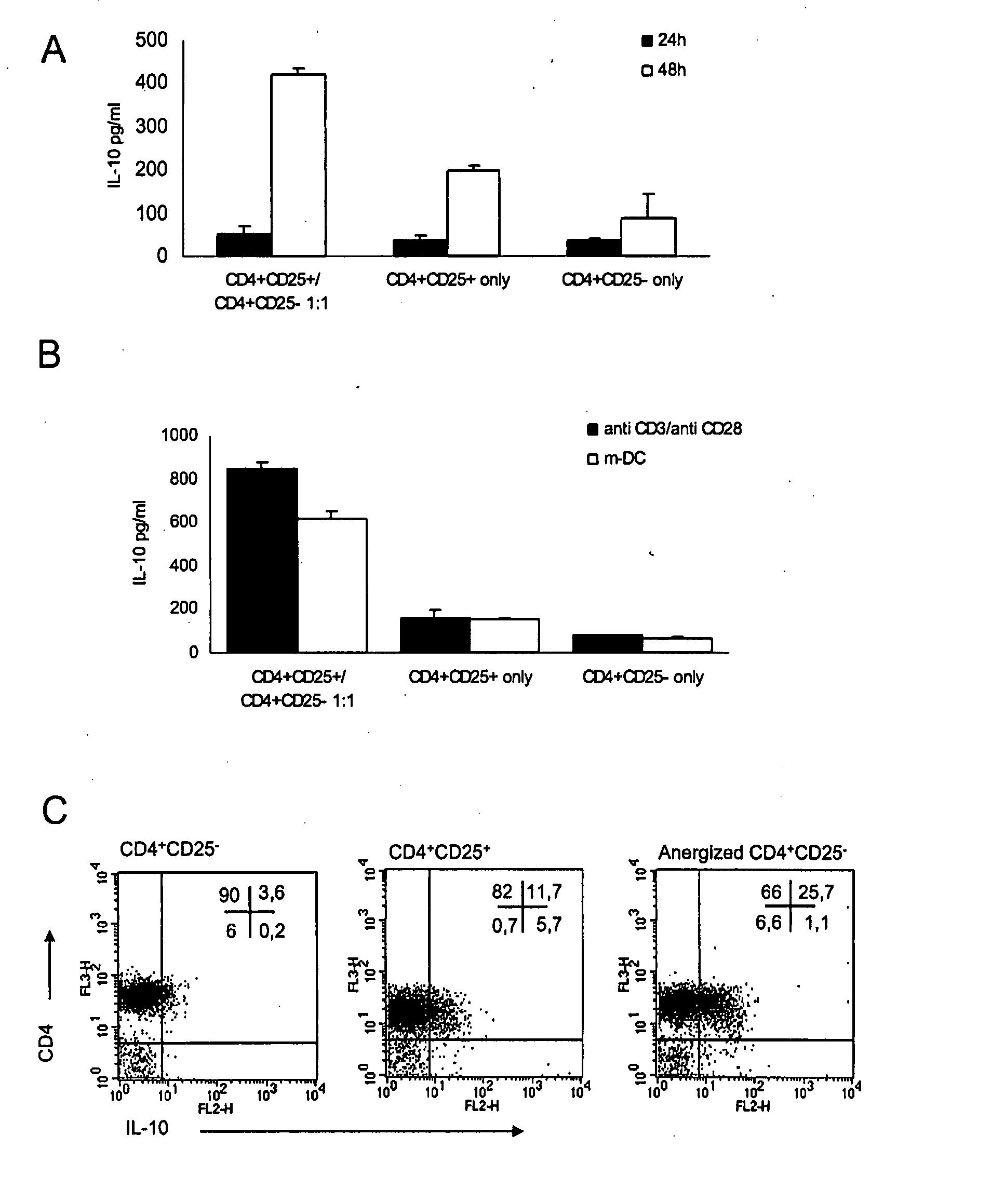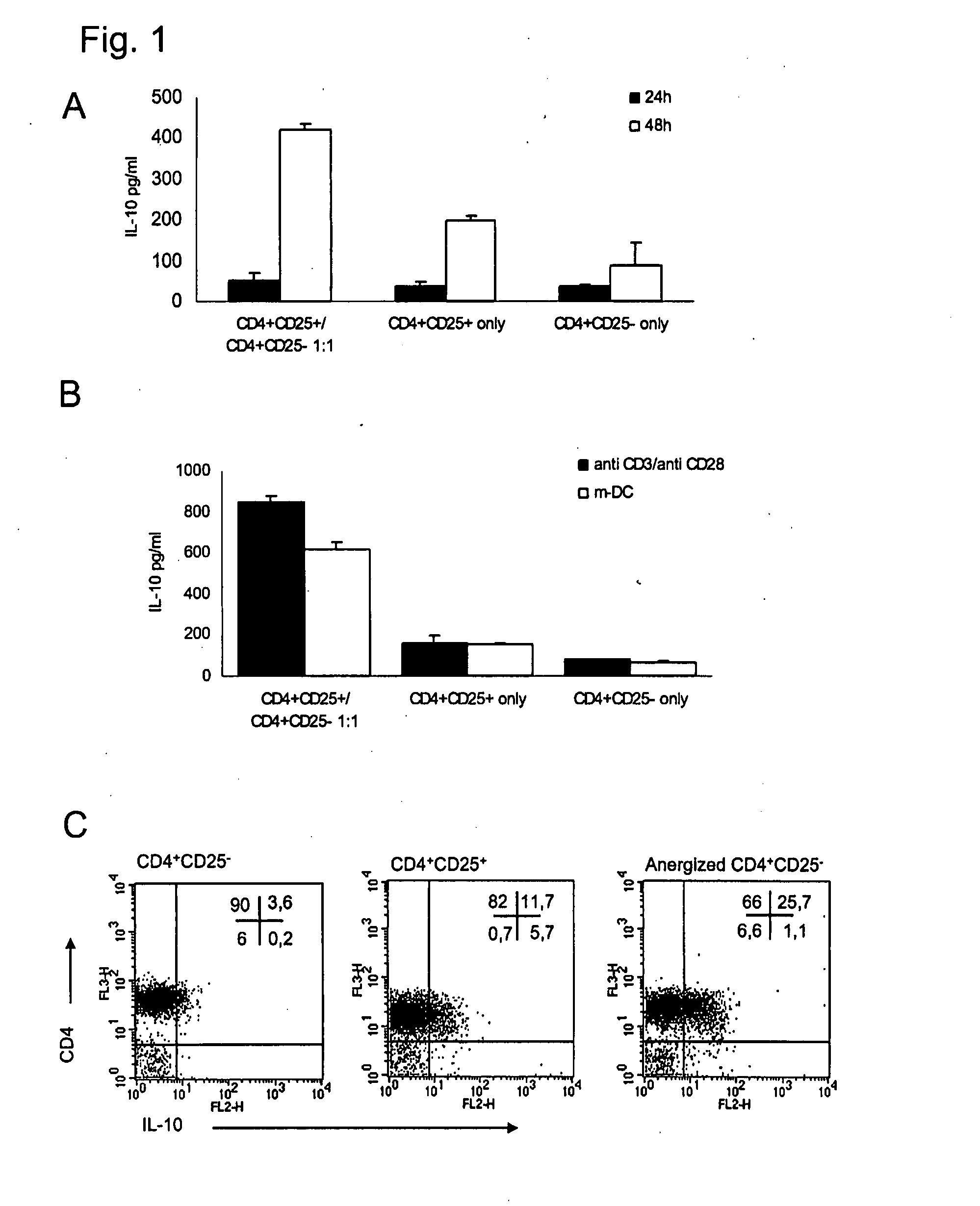CD4+CD25- T CELLS AND Tr1-LIKE REGULATORY T CELLS
a technology of tr1-like regulatory t cells and cd4+cd25-t cells, which is applied in the direction of immunological disorders, drug compositions, peptide/protein ingredients, etc., can solve problems such as difficult to understand, and achieve the effect of enhancing immune responses
- Summary
- Abstract
- Description
- Claims
- Application Information
AI Technical Summary
Benefits of technology
Problems solved by technology
Method used
Image
Examples
example 2
[0057] Activated, paraformaledhyd-Fixed CD4+CD25+T cells show similar regulatory capacity as viable cells.
[0058] It is known, that CD4+CD25+ T cells exert their regulatory function in a cell contact-dependent yet cytokine-independent manner. To further analyze their regulatory function, isolated CD4+CD25+ T cells were divided into three parts. One was activated over night polyclonally with platebound anti-CD3 and soluble anti-CD28 and fixed thereafter with paraformaldehyde (“activated-fixed”), the second part was fixed with paraformaldehyde without prior activation (“resting-fixed”) and the third part was left untreated (“viable”). After this procedure the three differently treated fractions of CD4+CD25+ T cells were used in regulation assays with syngeneic CD4+CD25− T cells. As shown in FIG. 2A activated-fixed CD4+CD25+ T cells had a similar regulatory capacity as their normal viable counterpart. This is in sharp contrast to resting-fixed CD4+CD25+ T cells which do not show any re...
example 5
[0064] Anergized CD4+CD25− T cells predominantly produce IL-10 . To analyze the cytokine secretion pattern of anergized CD4+CD25− T cells, CD4+CD25+ and CD4+CD25− T cells were sorted and stimulated alone or at a 1:1 mixture as described before. After 48 hours of culture supernatants were analyzed for the cytokines IL-2, IL-4, IL-5, TNF-α and INF-γ by a cytometric bead array, which allows multiparameter analysis in a single sample. As shown in FIG. 4, anergized CD4+CD25− T cells similar to CD4+CD25+ T cells do only produce very low levels of TNF-α and INF-γ and no IL-2,-4 or IL-5. CD4+CD25− T cells on the other hand produce high levels of IL-2, TNF-α and INF-γ and low to moderate levels of IL-4 and IL-5, resembling a TH1 phenotype. Surface phenotyping with the Abs mentioned in material and method did not reveal striking differences between activated CD4+CD25+, activated CD4+CD25− and cocultured CD4+CD25+ / CD4+CD25− T cells after 48 h of activation (data not shown).
PUM
| Property | Measurement | Unit |
|---|---|---|
| surface expression | aaaaa | aaaaa |
| soluble | aaaaa | aaaaa |
| concentrations | aaaaa | aaaaa |
Abstract
Description
Claims
Application Information
 Login to View More
Login to View More - R&D
- Intellectual Property
- Life Sciences
- Materials
- Tech Scout
- Unparalleled Data Quality
- Higher Quality Content
- 60% Fewer Hallucinations
Browse by: Latest US Patents, China's latest patents, Technical Efficacy Thesaurus, Application Domain, Technology Topic, Popular Technical Reports.
© 2025 PatSnap. All rights reserved.Legal|Privacy policy|Modern Slavery Act Transparency Statement|Sitemap|About US| Contact US: help@patsnap.com



